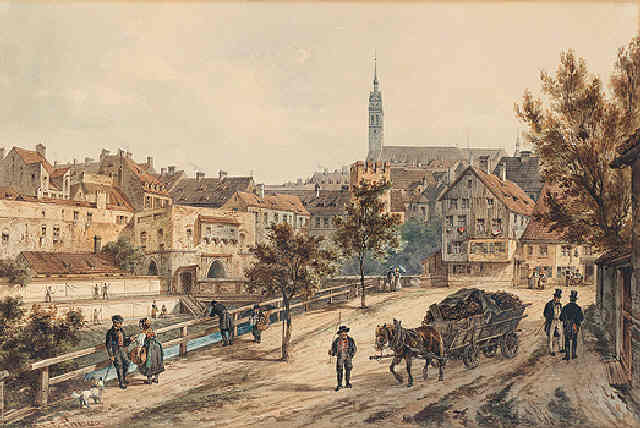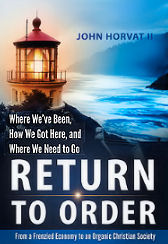In this atmosphere of cohesiveness and especially that of grace, the members of a society begin to idealize their life together. Some authors have referred to this sense of imagined perfection together as the creation of “utopias.” We feel this action is much better expressed in terms of how social units create their own myths, legends, or dreams.
All these terms refer to this indispensable capacity whereby families, social units, or peoples in their great unity, envision a future for themselves that considers both the practical means at hand and a higher ideal.

St. Peter’s Church, Scheibling tower and the The Münchner Stadtbäche, painted by Friedrich Perlberg.
“We have no knowledge of any human community where men do fail to dream,” writes Irving Kristol. “Which is to say, we know of no human community whose members do not have a vision of perfection—a vision in which the frustrations inherent in our human condition are annulled and transcended.”(1)
“The ideal society is not outside of the real society; it is a part of it,” writes Émile Durkheim. “Far from being divided between them as between two poles which mutually repel each other, we cannot hold to one without holding to the other.”(2)
“Without the metaphysical dream it is impossible to think of men living together harmoniously over an extent of time,” writes Richard Weaver. “The dream carries with it an evaluation, which is the bond of spiritual community.”(3)
The same author speaks similarly of myths as “great symbolic structures which hold together the imaginations of a people and provide bases of harmonious thought and action.” He points out how this world of value and meaning is a timeless structure, “always here and now,” and from which “the least member of a culture can borrow something to dignify and give coherence to his life.”(4) The legendary figure of George Washington, for example, serves as a point of unity for all those American values that he upheld. Any American at any time in our history can draw inspiration from his example. In a similar way, symbols and narratives can hold up a high ideal that imparts a style and tone to society that is found in fashion, manners, arts, architecture, and cuisine.
(1) Irving Kristol, Two Cheers for Capitalism (New York: Basic Books, 1978), 153.
(2) Émile Durkheim, The Elementary Forms of the Religious Life, trans. Joseph Ward Swain (London: George Allen and Unwin, 1915), 422.
(3) Richard Weaver, Ideas Have Consequences (Chicago: University of Chicago Press, 1984), 18.
(4) Richard Weaver, Visions of Order: The Cultural Crisis of Our Time (Wilmington, Del.: Intercollegiate Studies Institute, 1995), 34.
John Horvat, Return to Order: From a Frenzied Economy to an Organic Christian Society—Where We’ve Been, How We Got Here, and Where We Need to Go (York, Penn.: York Press, 2013), 324-5.











